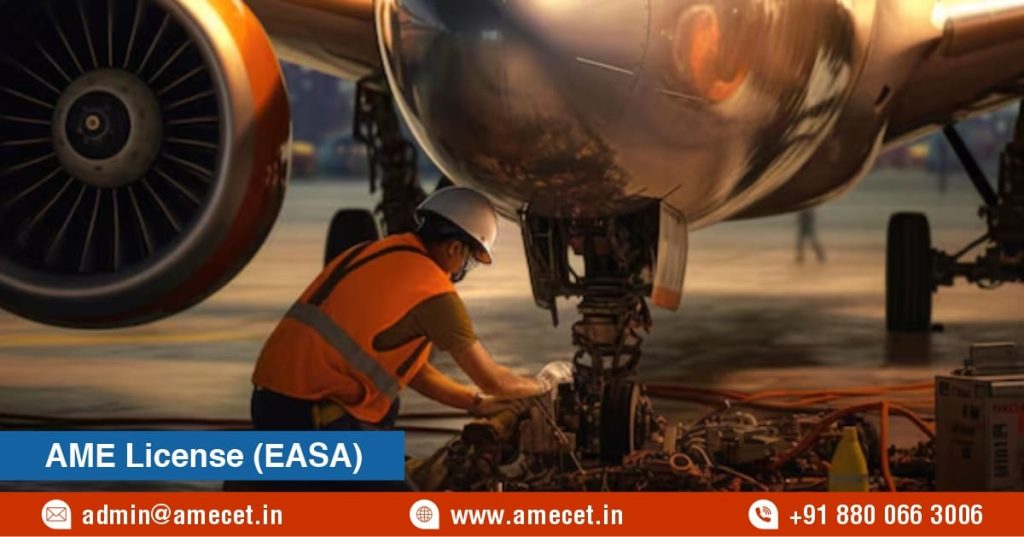How Do You Obtain an EASA AME License?
Posted on : 26 November, 2024 12:57 pm
To obtain an EASA Aircraft Maintenance Engineer (AME) license, candidates must first complete an approved Part-147 training course from a recognized aviation school. This training typically involves both theoretical and practical components. After completing the program, candidates must pass EASA Module exams, which test knowledge in areas such as aircraft systems, regulations, and maintenance practices. Additionally, candidates must gain hands-on work experience, usually a minimum of 2-5 years, depending on the license category. Once these requirements are met, applicants can apply for the EASA AME license through the relevant aviation authority.
Page Contents
ToggleEducational Requirements
The curriculum for obtaining an EASA Aircraft Maintenance Engineer (AME) license covers essential theoretical and practical knowledge. Students must complete subjects like aircraft systems, aerodynamics, maintenance practices, and safety regulations. Theoretical modules are complemented by hands-on training, providing real-world experience in aircraft maintenance. Accredited Part-147 institutions ensure students gain both technical expertise and familiarity with industry standards. The curriculum prepares candidates for EASA module exams and real-world challenges, ensuring they meet the strict safety and regulatory requirements of aviation.
Key Points
- Curriculum includes theoretical knowledge of aircraft systems, aerodynamics, and maintenance practices.
- Hands-on training is integrated to provide practical experience in real-world aircraft maintenance scenarios.
- Accredited Part-147 institutions offer structured programs for EASA AME certification.
- Safety regulations and aviation standards are emphasized throughout the curriculum.
- Students are prepared for EASA Module exams, ensuring comprehensive understanding of key subjects.
- The curriculum focuses on both technical expertise and compliance with industry regulations.
- Practical training includes troubleshooting and repairs of various aircraft components.
- Successful completion of the curriculum is essential for passing certification and obtaining the EASA AME license.
Choosing a Part-147 Approved Training Organization
Selecting a Part-147 approved training organization is crucial for aspiring Aircraft Maintenance Engineers (AMEs). These institutions are recognized by EASA to provide the necessary training and education for obtaining an EASA AME license. When choosing a training organization, consider factors such as accreditation, course offerings, faculty qualifications, and student support services. Additionally, reviewing the organization’s reputation and alumni success rates can help ensure a quality education. A well-chosen training organization provides a strong foundation for a successful career in aviation maintenance.
Key Points
- Part-147 approved organizations are recognized by EASA for providing quality AME training and education.
- Accreditation is essential to ensure the training organization meets EASA standards and requirements.
- Evaluate course offerings to ensure they cover all necessary theoretical and practical components of AME training.
- Faculty qualifications play a crucial role in delivering effective education and mentorship for students.
- Student support services, such as tutoring and career counseling, enhance the learning experience.
- Research the organization’s reputation through reviews and industry feedback to ensure quality education.
- Alumni success rates indicate the effectiveness of the training program in preparing students for careers.
- Location and facilities of the training organization can impact the overall educational experience for students.
Duration of Training
The duration of training for an EASA Aircraft Maintenance Engineer (AME) license typically spans two to four years. This includes theoretical coursework, practical training, and hands-on experience in aircraft maintenance. Part-147 approved organizations structure programs to balance classroom learning with real-world applications, ensuring comprehensive knowledge and skills. The timeline depends on the chosen certification category (A, B1, B2) and the intensity of the program. Completion of the program within this timeframe is crucial for eligibility for certification exams.
Key Points
- Training duration for EASA AME certification typically ranges from two to four years.
- Programs include theoretical knowledge and hands-on practical training for a comprehensive learning experience.
- Timeframes vary depending on the certification category (A, B1, B2).
- Full-time programs ensure faster completion, while part-time options offer flexibility for working professionals.
- The timeline includes mandatory work experience to meet EASA eligibility requirements.
- Accredited Part-147 organizations structure programs to meet industry standards.
- Efficient time management during training ensures successful completion within the allotted duration.
- Training equips candidates for certification exams and real-world maintenance challenges.
Theoretical Training
Theoretical training is a cornerstone of the EASA Aircraft Maintenance Engineer (AME) curriculum, focusing on foundational aviation knowledge. It covers key subjects such as aerodynamics, aircraft systems, maintenance procedures, and aviation regulations. This training ensures students understand the technical and regulatory aspects of aircraft maintenance. Delivered through classroom instruction, lectures, and study materials, theoretical training prepares students for EASA module exams. A strong grasp of theoretical concepts is essential for applying practical skills in real-world aircraft maintenance scenarios.
Key Points
- Theoretical training focuses on core subjects like aerodynamics, aircraft systems, and aviation regulations.
- It equips students with foundational knowledge crucial for understanding aircraft maintenance principles.
- Courses emphasize regulatory standards to ensure compliance with EASA safety requirements.
- Classroom instruction includes lectures, interactive discussions, and detailed study materials.
- Subjects cover troubleshooting techniques and maintenance procedures for various aircraft components.
- Theoretical training prepares students for EASA module exams and certification requirements.
- It develops problem-solving and analytical skills essential for diagnosing aircraft issues.
- A strong theoretical foundation complements practical training in real-world maintenance applications.
In conclusion, obtaining an EASA Aircraft Maintenance Engineer (AME) license requires completing a rigorous curriculum that combines theoretical training and practical experience. Theoretical training builds a solid foundation in subjects like aerodynamics, aircraft systems, and aviation regulations, ensuring compliance with industry standards. Practical training reinforces this knowledge through hands-on experience, preparing candidates for real-world challenges. Choosing a Part-147 approved training organization is crucial for quality education and certification eligibility. With dedication and the right training, aspiring AMEs can achieve their EASA license, opening doors to a rewarding career in aviation maintenance with global opportunities and long-term growth potential.

